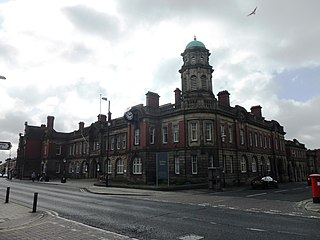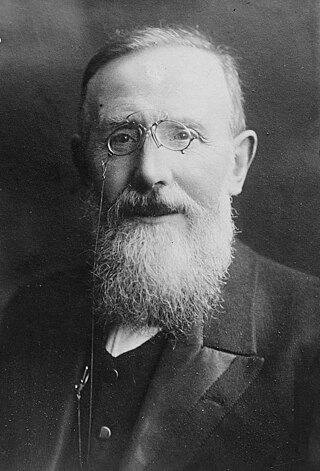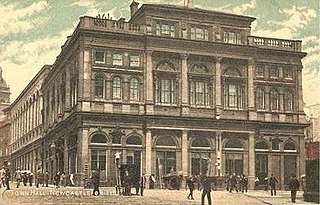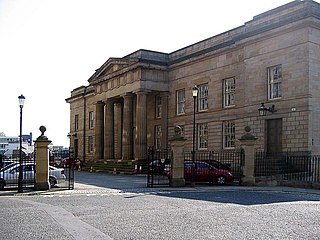In the United Kingdom and Republic of Ireland, a county town is the most important town or city in a county. It is usually the location of administrative or judicial functions within a county and the place where the county's members of Parliament are elected. Following the establishment of the English county councils in 1889, the headquarters of the new councils were usually located in the county town of each county. However, the concept of a county town pre-dates the establishment of these councils.

Northumberland is a county in North East England, one of the two counties in England that border on Scotland. Notable landmarks in the county include Alnwick Castle, Bamburgh Castle, Hadrian's Wall, Hexham Abbey and the tidal island Lindisfarne with the accompanying Lindisfarne Castle.

North Tyneside is a metropolitan borough in the metropolitan county of Tyne and Wear, England. It forms part of the greater Tyneside conurbation. North Tyneside Council is headquartered at Cobalt Park, Wallsend.

Hexham is a market town and civil parish in Northumberland, England, on the south bank of the River Tyne, formed by the confluence of the North Tyne and the South Tyne at Warden nearby, and close to Hadrian's Wall. Hexham was the administrative centre for the Tynedale district from 1974 to 2009. In 2011, it had a population of 13,097.

Rothbury is a market town and civil parish in Northumberland, England, on the River Coquet. It is 14 miles (22.5 km) northwest of Morpeth and 26 miles (42 km) of Newcastle upon Tyne. At the 2011 Census, it had a population of 2,107.

Morpeth is a historic market town in Northumberland, North East England, lying on the River Wansbeck. Nearby towns include Ashington and Bedlington. In the 2011 census, the population of Morpeth was given as 14,017, up from 13,833 in the 2001 census. The earliest evidence of settlement is believed to be from the Neolithic period, and some Roman artifacts have also been found. The first written mention of the town is from 1080, when the de Merlay family was granted the barony of Morpeth. The meaning of the town's name is uncertain, but it may refer to its position on the road to Scotland and a murder which occurred on that road. The de Merlay family built two castles in the town in the late 11th century and the 13th century. The town was granted its coat of arms in 1552. By the mid-1700s it had become one of the main markets in England, having been granted a market charter in 1200, but the opening of the railways in the 1800s led the market to decline. The town's history is celebrated in the annual Northumbrian Gathering.

Thomas Burt PC was a British trade unionist and one of the first working-class Members of Parliament.

Morpeth is a railway station on the East Coast Main Line, which runs between London King's Cross and Edinburgh Waverley. The station, situated 16 miles 50 chains north of Newcastle, serves the market town of Morpeth, Northumberland, England. It is owned by Network Rail and managed by Northern Trains.

Newcastle Central Station is a major railway station in Newcastle upon Tyne. It is located on the East Coast Main Line, around 268 miles (432 km) north of London King's Cross. It is the primary national rail station serving Newcastle upon Tyne, with local rail services provided by the Tyne and Wear Metro network to which the station is connected to by Central Station Metro station, situated beneath the national rail station.

Riding Mill is a village near Hexham in Northumberland, England. It is part of the civil parish of Broomhaugh and Riding. It is served by Riding Mill railway station and by a frequent bus service on the route from Hexham to Newcastle.
The Blyth and Tyne Railway was a railway company in Northumberland, England, incorporated by Act of Parliament on 30 June 1852. It was created to unify the various private railways and waggonways built to carry coal from the Northumberland coalfield to Blyth and the River Tyne, which it took control of on 1st January 1853. Over time, the railway expanded its network to reach Morpeth (1857/8), North Seaton (1859), Tynemouth (1860/1), Newcastle upon Tyne (1864), and finally Newbiggin-by-the-Sea (1872). It became part of the much larger North Eastern Railway in 1874.

Northumberland County Council is a unitary authority in North East England. The population of the non-metropolitan unitary authority at the 2011 census was 316,028.

Ashington is a town and civil parish in Northumberland, England, with a population of 27,864 at the 2011 Census. It was once a centre of the coal mining industry. The town is 15 miles (24 km) north of Newcastle upon Tyne, west of the A189 and bordered to the south by the River Wansbeck. The North Sea coast at Newbiggin-by-the-Sea is 3 miles (5 km) away.

The Northumberland Football Association is a governing body in the historic county of Northumberland, England. The association was formed in 1883. It is responsible for the governance and development of football at all levels in the county.
Coxlodge is an area situated between Fawdon, Gosforth and Kenton in Newcastle upon Tyne, England.

The North of Tyne Combined Authority is a mayoral combined authority which consists the local authorities of Newcastle upon Tyne, North Tyneside, and Northumberland, all in North East England. The authority came into being on 2 November 2018 under the statutory name Newcastle upon Tyne, North Tyneside and Northumberland Combined Authority. The three local authorities previously formed part of the North East Combined Authority, which still exists in a smaller form. The two combined authorities cooperate on the North East Joint Transport Committee.

The Town Hall was a local government building located in St Nicholas Square, Newcastle upon Tyne.

County Hall is a municipal building in Morpeth, Northumberland, United Kingdom. It is the offices and meeting place of Northumberland County Council. The current building was completed in April 1981, after the county hall was moved from the old county hall in Newcastle. A statue of a Viking Warrior stands outside the building and was moved there from Doxford Hall.

The Moot Hall is a courthouse at Castle Garth in Newcastle upon Tyne, England. The structure, which overlooks the Tyne Bridge, is a Grade I listed building.
The county of Northumberland has returned four MPs to the UK Parliament since 1983. Under the Local Government Act 1972, which came into effect on 1 April 1974, the boundaries of the historic/administrative county were significantly altered with the south-east of the county, comprising more than half the electorate, being transferred to the new metropolitan county of Tyne and Wear. These changes were reflected in the following redistribution of parliamentary seats which did not come into effect until the 1983 general election, resulting in a reduction in the county's representation from 10 to 4 MPs.

















